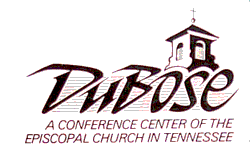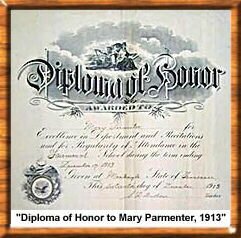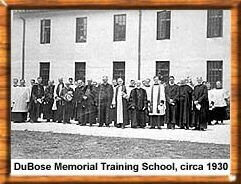|


Article taken from The Chattanooga Times, Saturday, August 14, 1982
 |
Visitors, looking across the tree-shaded grounds of DuBose Conference Center on top of Monteagle Mountain, might well imagine they could yet hear wafting on the soft breezes the voices of the young ladies from across the Southland who came to the isolated village of Moffat's Station to attend Fairmount College. It was a totally different world in 1872 when Mrs. Louise Yerger and Mrs. Harriet Kells moved their girls' school from Jackson, Miss., to the mountain. Both women, widows who had survived the War Between the States, were determined to pass along to the younger generation the cultural and social values they deemed so important. |
Mrs. Kells is quoted as saying that "within doors was the digging for Latin and French and mathematical roots; outside, the grubbing hoe and axe wrought their more evident transformations." In time, the yard included a flower garden and orchard, tennis courts, a ball ground and a well-kept lawn which, in early spring, was studded with wood violets. An old water pump and several large trees remain from those early years.
The site of Moffat's Station, as Monteagle was first named, was chosen by two women as a compromise between two competing areas: a co-educational school at Sewanee, home of the University of the South, as urged by the Bishop of Mississippi, or 500 acres of land at Tracy City, offered by the Tennessee Coal and Railroad Company.
The women's decision was made possible by the offer of 50 acres of land by Col. John Moffat, a Scotch-Canadian temperance lecturer who owned the entire top of the mountain, from bluff to bluff in one direction and from the boundary of the University of the South to the mountain top on the east where the school was located. In addition to the land, Moffat also built the first building, with the cost interest free for the first five years and a total of 20 years to pay it off. The help and interest of the University of the South and the Tennessee Coal and Railroad Company continued. The railroad line ran close to the school, with connections to many points in the country and often provided special service for the school.
| Sewanee provided for the spiritual needs of the school by supplying a chaplain, Dr. William Porcher DuBose, who also taught theology at the University. Formerly of Charleston, S. C., DuBose was the first Chaplain at Sewanee following the war. Several years later, Dr. DuBose and Mrs. Yerger were married, as he had found in her "a woman of intellectual acquirements and a real thinker." By this time, the University of the South had found it necessary to provide home discipling and cultural environment for their students, so the DuBoses moved back to Sewanee and into the recently completed St. Luke's Hall. |

|
A few years later, Mrs. Kells returned to Jackson for a visit and remained to establish, with the help of Frances Willard, the first Women's Christian Temperance Union in Mississippi.
At Fairmount, meanwhile, Silas McBee, later to gain fame as author and architect, was installed as principal. He turned the school into a church institution that might be "for girls what Sewanee was for young men." In line with this idea, there were courses of lectures by Sewanee professors given to the students at Fairmount.
McBee also instituted very strict regulations, including "no dresses of silk, satin or velvet" nor "expensive articles of jewelry." The students could write no more than two letters a week, one of which must be to the family, and absolutely no letters or visits from "young gentlemen."
Some years later, after brief leadership by others, Dr. DuBose's children assumed leadership of the school. His son, William, was business manager; daughter Susan was principal and May a teacher. Among the students during this period were the Soong sisters from China, one of whom later became Madame Chiang Kai-Shek. The school, born in the wake of one war, closed its doors with the advent of World War I.
Following the war, the property was acquired for the DuBose Memorial Church Training School. The organization, which included several prominent Chattanooga Episcopal laymen, came into being through the interest of Dr. William Stirling Claiborne in providing a place to train mature men with professional and business experience for the rural ministry.
The school was operated on a self-help basis, with the students working on the farm and maintaining the buildings, as well as attending class and studying. The frame buildings burned to the ground during the winter of 1924, but rebuilding soon began, paid for through an aggressive building fund program, which included fund-raising social events in New York City, sponsored by celebrities such as Franklin D. Roosevelt, then a New York lawyer, and Judge William McAdoo. The buildings were erected and the school back in business a year after it burned. The school flourished after that, with many church leaders trained there, including several bishops. The Rt. Rev. Reuss-Froylan, Bishop of Puerto Rico, was a graduate of the DuBose School.
With the coming of World War II, the school was closed. The number of students had declined, due to the war, and other seminaries were now accepting married men, so that the original purpose of the school no longer existed.
The buildings and grounds remained in the hands of the DuBose School board, but were leased to the Tennessee Diocese of the Episcopal Church for a camp and conference center. Finally, in 1956, the trustees of the school offered the property to the Diocese, which bought it and began capital improvements.
Today, it is open year round for camps, conferences, meetings and recreational events, offering a spiritual and educational center for the now three Dioceses of Tennessee. It also is open to other religious and secular groups.
Located just off I-24 at Monteagle, it still is a quiet and sheltered nook. The original building, Claiborne Hall, listed on the National Register of Historic Places, it is the hub of the campus, and a quiet lobby is the hub of Claiborne. Beyond the lobby are the kitchen and a spacious dining room.
The outside of the three-story building shows a strong Moroccan influence in color and construction. On either side on the lobby and on the two upper floors are the old dormitory rooms, now used to house those coming to meetings at the center. There is a single bathroom for each wing on each floor. In addition to this, there is another building, built by Holiday Inn, with typical motel-type rooms, with individual bath.
These rooms are sufficient when there is only less then 200 attendees. Often there are larger groups, (Laymen) but there are enough motels in the immediate area to take care of the overflow. When possible, all meals are served at the center, sometimes necessitating removing the furniture from the lobby and setting up tables there. In addition, there is a small library and a number of conference rooms.
There are two chapels. The older one is situated at the end of Claiborne Hall. The larger chapel, in the newer section, can accommodate about 200.
For the recreation-minded, there is a covered outdoors building suitable for crafts or assembly programs or for picnics. There is also a sparkling swimming pool on the grounds, and numerous hiking opportunities nearby for the adventurous outdoor group experience.

Home | Accommodations | Mountain Location | Links | Contact Us
Meeting Space | Summer Camp | Nature Quest | Calendar of Events | History
|